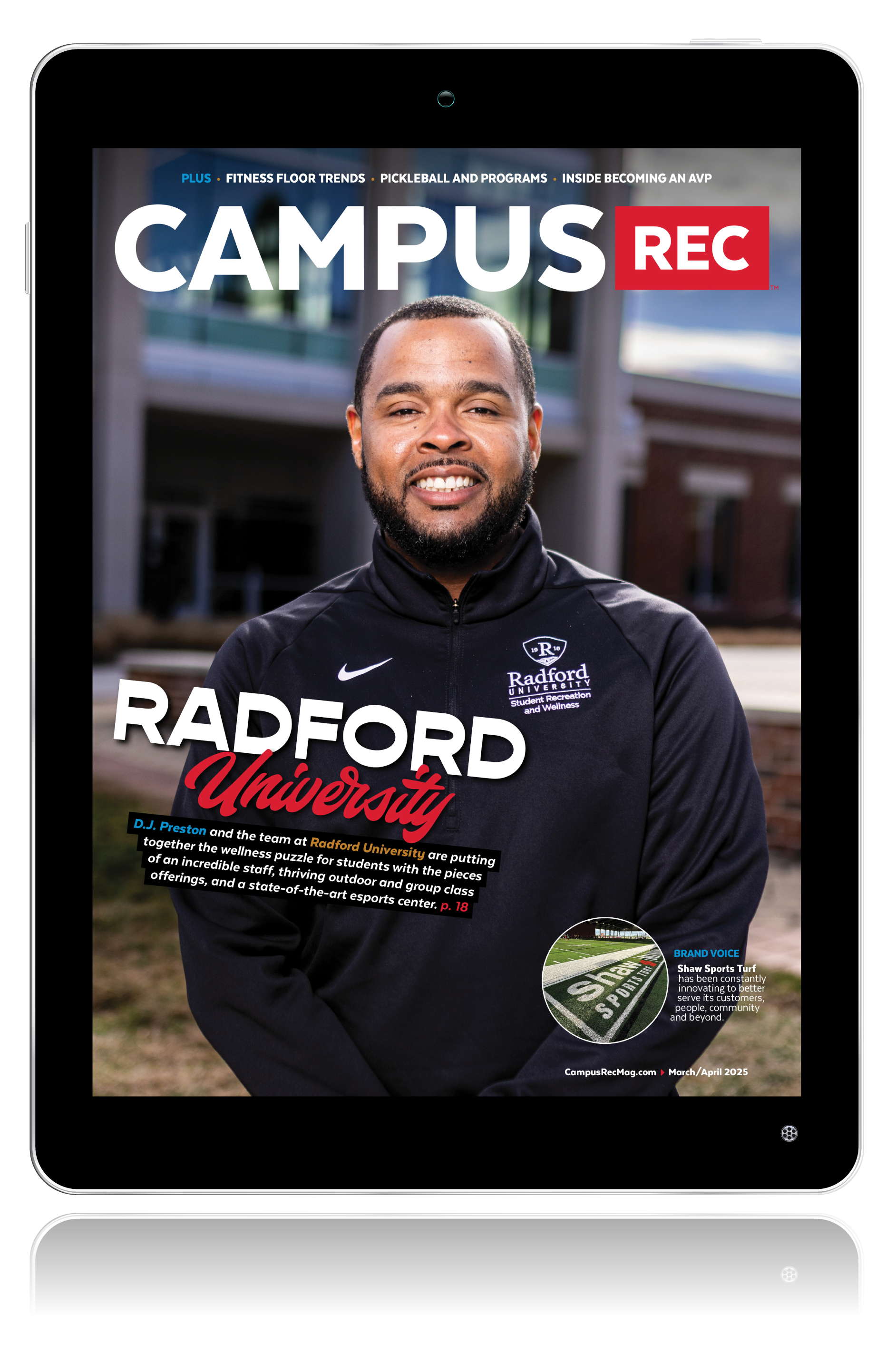
Campus Recreation has prided itself on being a place where all students feel welcome. We’ve focused on training staff to provide friendly and helpful customer service when students arrive at our rec centers, greeting everyone with a smile. Often, our intentional focus on welcoming ends at the customer service desk, but also includes program instructors, wayfinding, accessibility, music and imagery, spacemaking, staffing diversity, risk management, and participant demographics.
The “Welcome” is the way in which someone is met and spoken to when they arrive in your facility and program. It is the culture, behaviors and understanding a participant experiences and/or observes. How are they made to feel comfortable, important, and accepted by staff, instructors, lifeguards, referees and fellow participants? Are your programs, policies, facilities and structures created with a welcoming environment for all in mind?
Imagine being invited to someone’s home for the first time. You ring the doorbell and someone shouts at you to “come in!” You enter tentatively, being greeted by a bustle of activity. Some people are dancing and others watching television. There are people cooking in the kitchen, and a group playing a board game. Some people have their shoes on, others don’t. Some are wearing fancy clothing while others are in sweatpants and hoodies.
The person who invited you is nowhere to be seen, you don’t know a single soul and you have no clue what is going on. Suddenly someone approaches you, smiles, says hello, checks your ID, ushers you in and wishes you a good day. Do you feel welcome? This scenario, though outlandish, isn’t too much outside of the realm that one may experience in campus recreation.
We assume students coming to our facilities feel welcome because we provided time to play, posted funny memes on social media and offered programs we think students want. The fault lies in the current culture that puts the ownership on students to navigate the challenging landscape of campus recreation. There is little to no intentional effort to create a sense of belonging outside of general customer service. We hope the participants will figure it out themselves.
This approach works fine for students who understand most of the culture, rules and expectations that comes with the traditional sport and rec environment. They just need to know the specifics of your particular facility and programs. But what about those students new to sport and recreation, or who have been out of it for a long time? What can we do to ease the stress that comes when entering this new environment?
Provide Training and Development that Prioritizes a Welcoming Environment
We value certifications, technical skills and experience from our instructors, yet most participants will gravitate and give positive feedback because they like how the instructor made them feel, both physically and socially. Many of the fitness classes I have participated in often started with the instructor yelling into a microphone, a quick introduction and beginning with a warm-up. For seasoned fitness goers, this is normal, but what about someone new? Do you give time before and after classes to orientate, answer questions or get to know your participants?
Incorporate Virtual to Feel Welcome
What can we do to help students feel comfortable even before they arrive? Show the participants, instructors and facilities in an authentic way; the different skill levels, the feel of programs, the variety of activities and the diversity of the members. Create virtual tours that have personality so prospective members can feel like they have been to your facility before. Have real staff introduce themselves so participants feel like they have met them before. Remember, if your video doesn’t reflect the actual experience, new participants won’t be fooled and most likely will not stick around for long.
When I registered for a drop-in basketball league, I got a text from the organizer, who introduced himself asked me if I had any questions, and went over some of the expectations. He also asked me to see him in the gym when I arrived to ensure I felt comfortable about the process. When I showed up, he greeted me and introduced me to the other players, who also did a wonderful job of making me feel welcome.
It Takes More Than a Smile to Feel Welcome
What participants see or don’t see in your facility is just as important in feeling welcome. Are your spaces accessible? Do the sounds and imagery they experience make them feel comfortable? Do they see themselves reflected in the staff, programs and participants? Are they able to navigate the facility easily?
I worked at an institution where the climbing wall was behind a large glass enclosure. Though any student was welcome to use the wall, the glass acted as an unwelcoming barrier, as students assumed you needed special privileges and therefore didn’t feel welcome to use a section of the facility meant for them.
Think of the impact gender-specific changing rooms have on welcoming non-binary students. How many of your staff address a group of students in an activity as “guys?” Are participants able to use discriminatory, racist or homophobic language without recourse? All of these things have a significant impact on a student feeling welcome in your spaces and programs.
Facilitate the Welcome Experience
Many campus rec programs are facilitated by instructors, league staff, referees and personal trainers, but what about those activities that aren’t formally organized? Do you intentionally approach students in the fitness center or pool that appear to be mystified to help answer questions and make them feel comfortable? During drop-in sports, do you have someone who educates participants on the format, expectations and rules of play, or do you put that on the participants? Organic play can be very beneficial to student development, but can also lead to exclusion where some players may not feel welcome in the space. Is there a way to do both? Alleviating stress and unknowns for students is paramount in helping them feel welcome.
It is everyone’s role, not just the customer service staff, to make students feel welcome in the rec center and in our programs. When we see the experience through a new participant’s eyes, we begin to understand the complexity and challenges they face as they brave a new environment. Let us be more intentional about how we welcome them so they feel like they belong. Next time on The Power of Belonging in Campus Recreation is Inclusion: The Space to Be Yourself.










